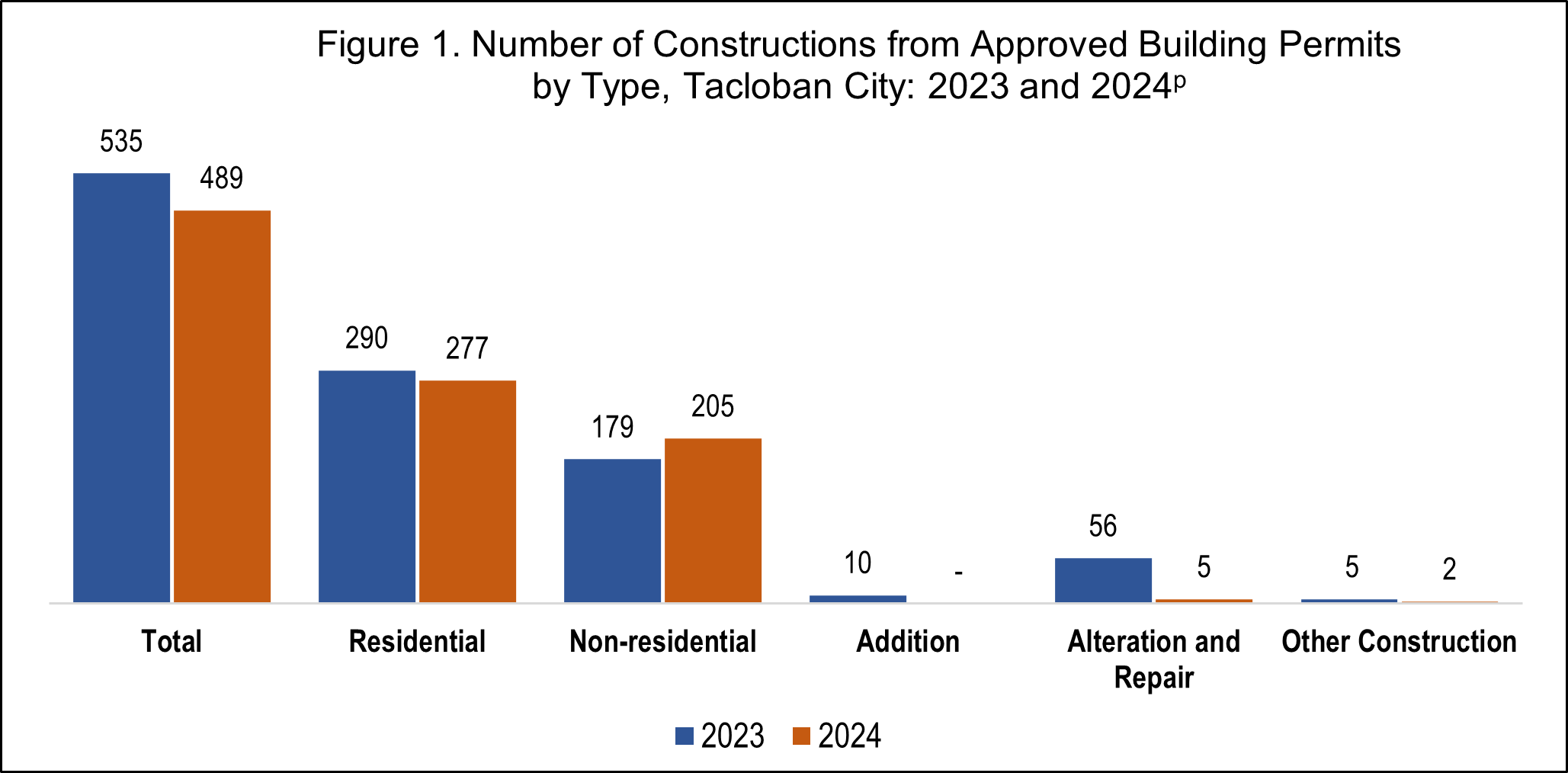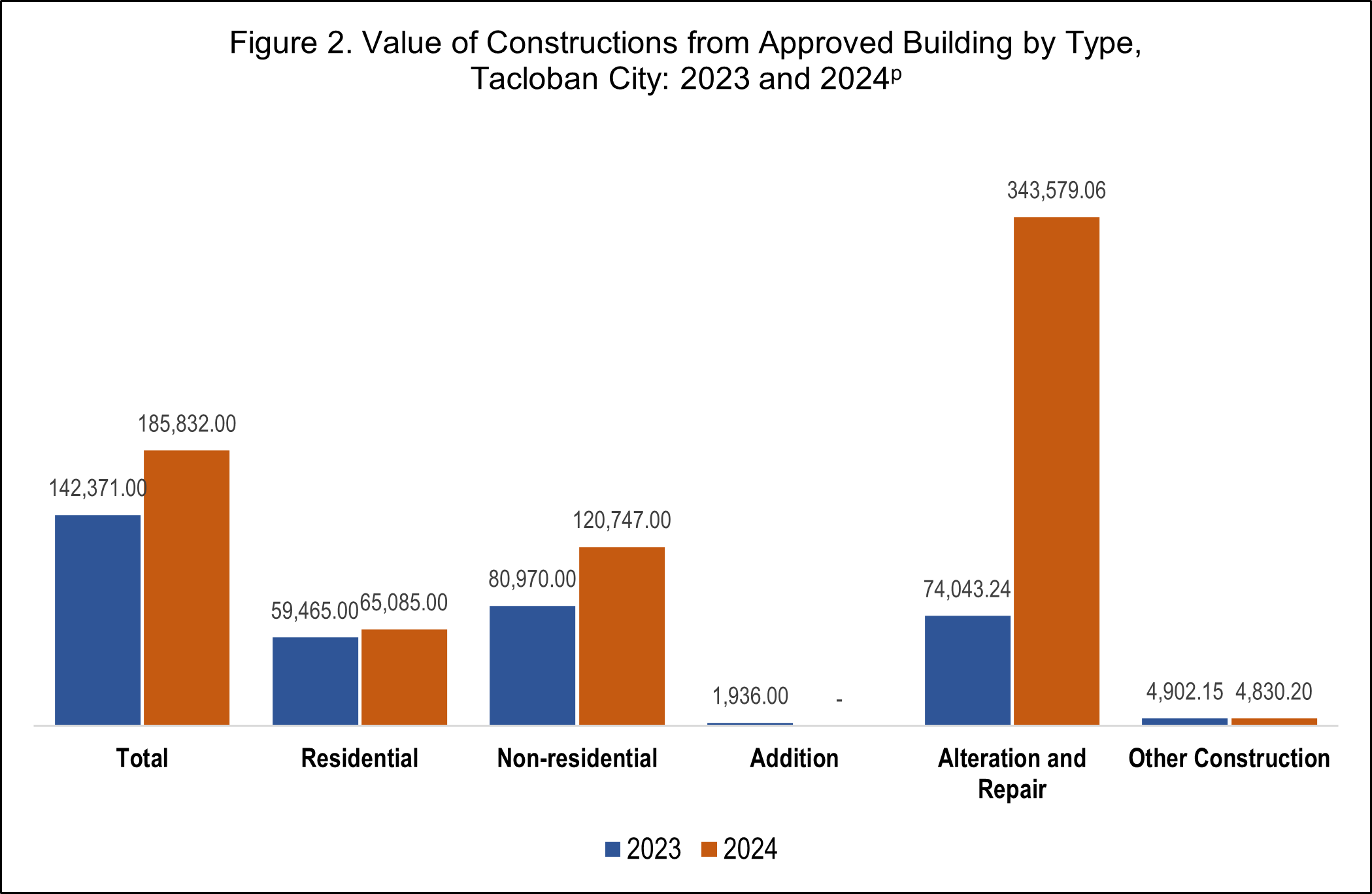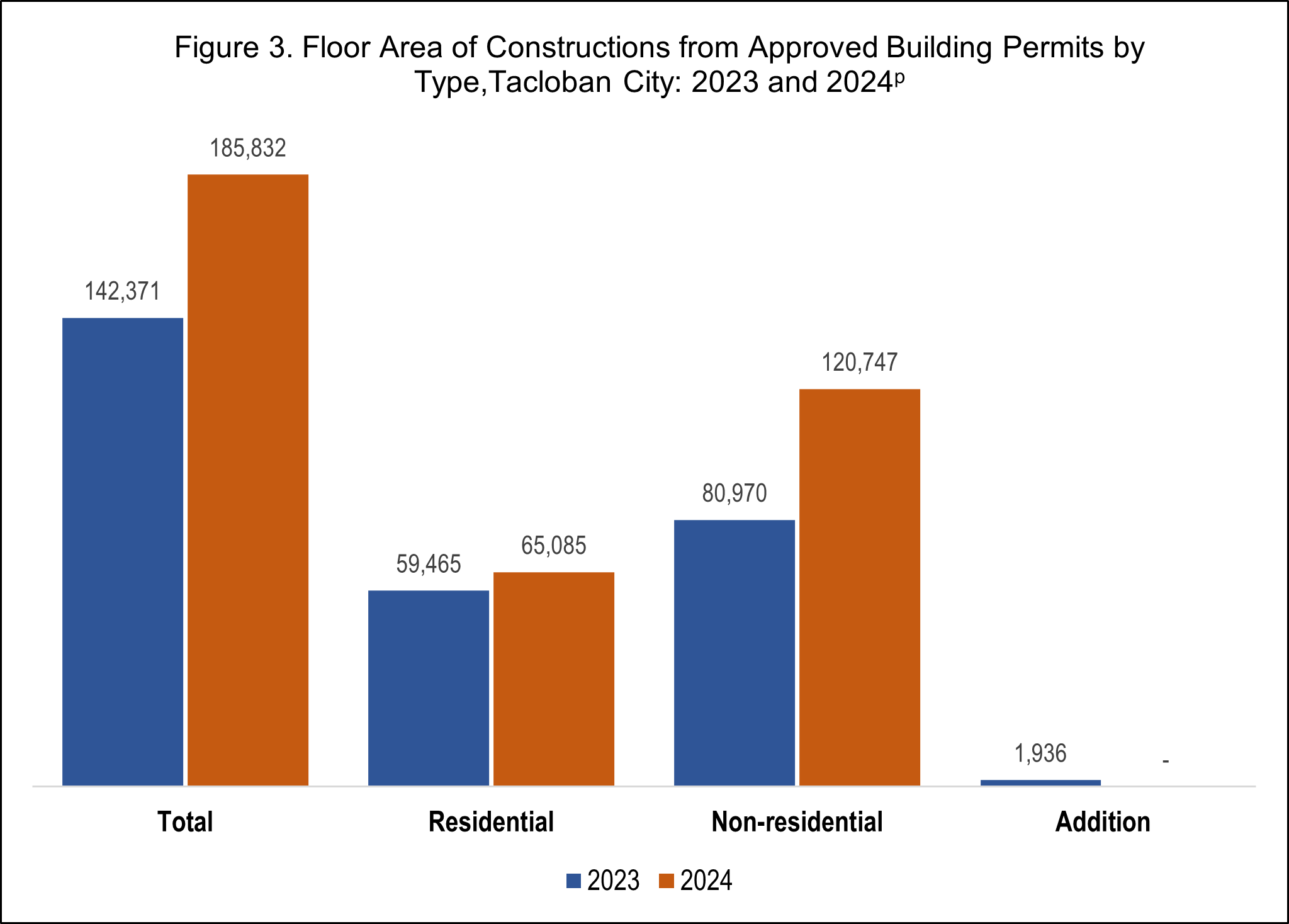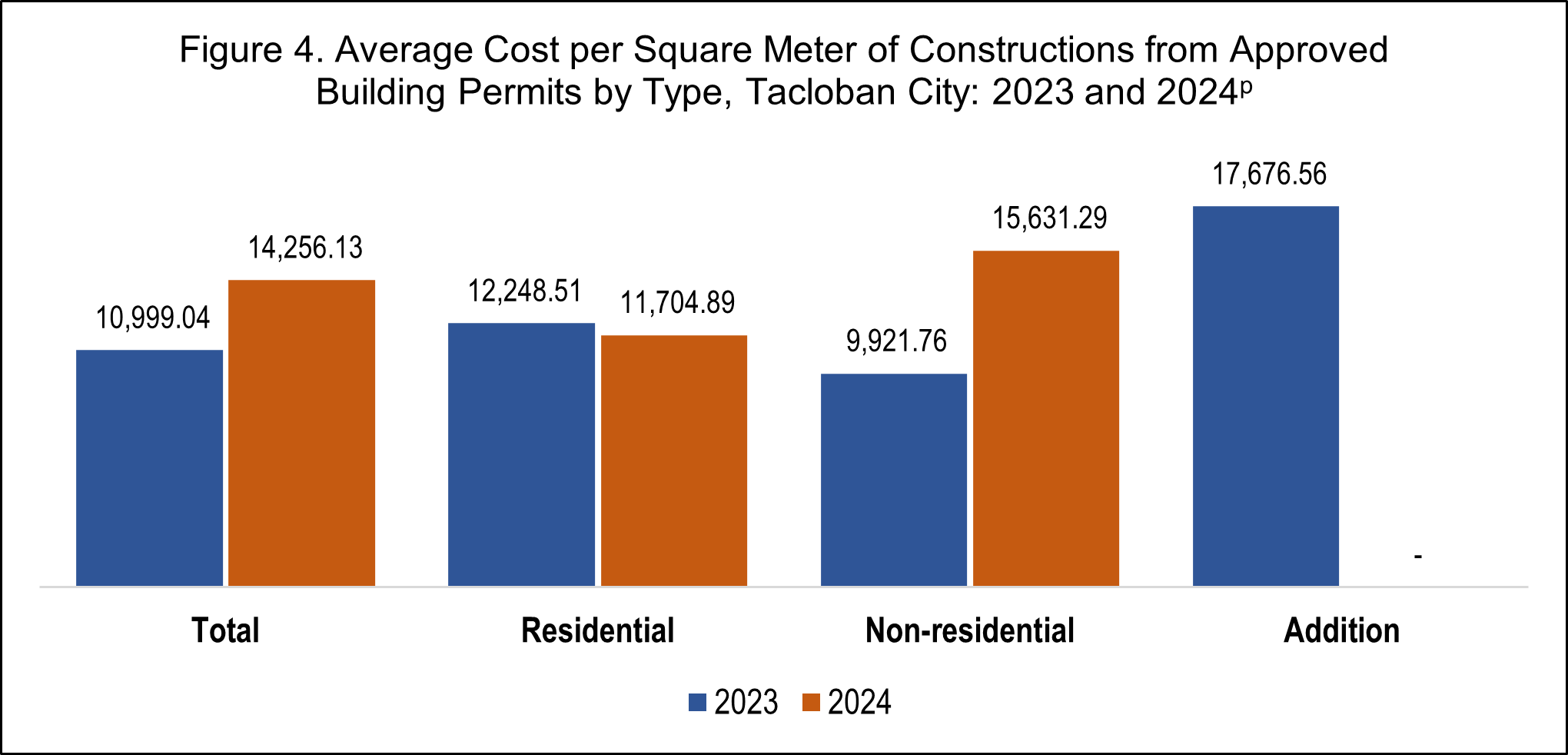Approved Building Constructions in Tacloban City down to 489 in 2024
The number of constructions from Approved Building Permits in Tacloban City went down to 489 in 2024. This indicates an annual decrease of 8.79 percent from the 535 total number of constructions in 2023.
By type of construction, residential buildings reported the highest number of constructions at 277 or 56.65 percent of the total number of constructions in 2024. This recorded an annual decrease of 4.48 percent from previous year's level of 290 constructions. All of the reported residential constructions in Tacloban City were single-type houses.
Meanwhile, non-residential type of construction was the second highest in terms of number of constructions at 205 or 42.92 percent of the total number of constructions in 2024. This type of construction increased at an annual rate of 14.53 percent. Most of the non-residential constructions were commercial buildings with 160 constructions (78.05%).

There were five (5) reported alteration and repair of existing structures in 2024 contributing 1.02 percent to the total number of constructions. This number dropped by 91.07 percent from 56 reported alteration and repair in 2023. Meanwhile, there was no recorded addition to any new construction to increase height or area of an existing building/structure.
Non-residential buildings recorded the highest value of constructions
In 2024, the total value of constructions in Tacloban City amounted to ₱ 2.997 billion, reflecting an annual increase of 82.79 percent from the ₱ 1.64 billion value of constructions posted in 2023.

Non-residential building constructions valued at ₱ 1.89 billion accounted more than half (62.96%) of Tacloban City’s total value of constructions in 2024. This indicates an annual increase of 134.94 percent from the ₱ 0.80 billion construction value of non-residential buildings recorded in 2023. Among non-residential constructions, institutional-type buildings had the highest value of constructions at ₱ 1.18 billion comprising 62.71 percent of the total value of non-residential constructions in 2024.
Meanwhile, the construction value of residential buildings amounted to ₱ 0.76 billion or 25.41 percent of the total construction value in 2024. This translates an annual increment of 4.59 percent from the ₱ 0.73 billion value of constructions of residential buildings reported in the previous year.
Non-residential buildings accounted for more than half of the total floor area of constructions
The total floor area of constructions in Tacloban City in 2024 was recorded at 185,832 square meters. This excludes alteration and repair, other non-residential such as facade, helipad, niche, water tank, etc., and other constructions, which include demolition, street furniture, landscaping, and signboards, since there is no reported floor area for these types of constructions. The total floor area in 2024 registered an annual increment of 30.53 percent from the recorded 142,371 square meters floor area in the previous year.
Non-residential constructions posted 120,747 square meters or 64.98 percent of the total floor area of constructions in 2024. This reflects an annual increase of 49.13 percent from the recorded floor area of non-residential constructions at 80,970 square meters in 2023.

Meanwhile, residential constructions recorded 65,085 square meters or 35.02 percent of the total floor area of constructions in 2024. It increased at an annual rate of 9.45 percent from the previous year's floor area of 59,465 square meters.
Residential buildings had the highest average cost of constructions
The average cost of constructions in Tacloban City in 2024 was recorded at ₱14,256.13 per square meter. This was 29.61 percent higher than the average cost of ₱10,999.04 per square meter in 2023. Alteration and repair, other non-residential such as facade, helipad, niche, water tank, etc., and other constructions, which include demolition, street furniture, landscaping, and signboards, were excluded in the average cost of construction since there is no reported floor area for these types of construction.
By type of construction, non-residential buildings had the highest average cost of ₱15,631.29 per square meter in 2024. This was followed by residential constructions with ₱11,704.89 per square meter.

Single house constructions, the only recorded residential construction type, posted an average cost of ₱11,704.89 per square meter in 2024.
Across non-residential constructions, institutional buildings reported the highest average cost of ₱26,015.75 per square meter. On the other hand, commercial buildings recorded an average cost of ₱9,352.51 per square meter.
SGD. SHERYL ANN A. JAMISOLA
Chief Statistical Specialist
TECHNICAL NOTES
The definition of terms is adopted from the Revised and Updated IRR of the NBC.
Accesoria is a one or two-floor structure divided into several dwelling units, each dwelling unit having its own separate entrance from the outside.
Addition refers to any new construction which increases the height or area of an existing building/structure.
Agricultural buildings are buildings used to house livestock, plants, and agricultural products such as barns, poultry houses, piggeries, stables, greenhouses, and grain mills.
Alteration is a construction in a building/structure involving changes in the materials used, partitioning and location/size of openings, structural parts, existing utilities, and equipment but does not increase the overall area thereof.
Apartment is a structure, usually of two storeys, made up of independent living quarters, with independent entrances from internal walls and courts.
Building refers to any independent, free-standing structure comprised of one or more rooms or other spaces, covered by a roof and enclosed with external walls or dividing walls, which extend from the foundation to the roof.
Building permit is a written authorization granted by the LBO to an applicant allowing him to proceed with the construction of a specific project after plans, specifications, and other pertinent documents have been found to be in conformity with the NBC.
Commercial buildings refer to office buildings and all buildings which are intended for use primarily in wholesale, retail, and service trades; i.e., stores, hotels, restaurants, banks, disco houses, etc.
Construction refers to all on-site work done from site preparation, excavation, foundation, assembly of all the components and installation of utilities, machineries, and equipment of buildings/structures.
Conversion is a change in the use or occupancy of structure or any portion thereof, which has different requirements.
Duplex house is a structure intended for two households, with complete living facilities for each; it is a single structure divided into two dwelling units by a wall extending from the floor to the ceiling.
Industrial buildings are buildings used to house the production, assembly, and warehousing activities of industrial establishments; i.e., factories, plants, mills, repair shops, machine shops, printing press, storage plants, electric generating plants.
Institutional buildings are buildings which primarily engaged in providing educational instructions and hospital/health care; ports, airports and other government buildings; i.e., schools, museums, libraries, sanitaria, churches, hospitals.
Non-residential building includes commercial, industrial, agricultural, and institutional buildings.
Other constructions are non-building structures which includes:
Demolitions refer to the systematic dismantling or destruction of a building / structure, in whole or in part.
Floor area of building refers to the sum of the area of each floor of the building measured to the outer surface of the outer walls including the area of lobbies, cellars, elevator shafts, and all communal spaces in multi-dwellings. Areas of balconies are excluded.
Street furniture are street structures consisting of monuments, waiting sheds, benches, plant boxes, lampposts, electric poles, and telephone poles.
Total value of construction refers to the sum of the cost of building, electrical, mechanical, plumbing, and others. The value is derived from the approved building permit and represents the estimated value of the building or structure when completed.
Other non-building constructions include cemetery structures, street furniture, waiting sheds, communication towers, etc.
Other residential construction consists of school or company staff houses, living quarters for drivers and maids, and guardhouses.
Renovation is any physical change made on structures to increase their value and quality.
Repair is a remedial work done on any damaged or deteriorated portion/s of a building/structure to restore its original condition.
Residential building is a building for which its major parts or more than half of its gross floor area is built for dwelling purposes. This type of building can be of the single type, duplex, apartment and/or accessoria, and residential condominium.
Residential condominium is a structure, usually of several storeys, consisting of multiple dwelling units.
Single house is a complete structure intended for a single family or household, i.e., bungalow, 2-storey house, nipa hut, etc.

